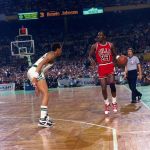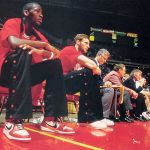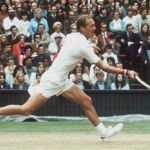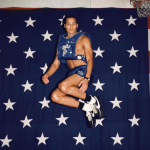
Sneakers' history as told in "Golden Kicks"
New Sport Side
September 27th, 2016
Some of the stories about our favorite shoes are known by everyone. Others are more hidden, more remote, and only the real fans know them. Then there are the classic ones, which trace a path at the end of which you realize you really learned something about it. The book "Golden Kicks", published by Bloomsbury, tells all the stories about the "shoes that changed the sport", as the subtitle points out. We reached the author, Jason Coles – a life spent in the sports business – who told us how the project came about, unveiling on some of the lesser known parts of the story and confirming our beliefs on other essential points. What comes out is a kind of essay on the subject, an excellent introduction for those aiming to read the book.
Hello Jason, I’m very glad to talk to you. I’d like to start this interview by asking you how and when did you decide to start this book?
During my career in the sports business I met many people who had been part of adidas, Puma and Reebok history and I loved hearing their stories about how certain shoes were developed and about the athletes who wore them. In particular I loved the story about the Dassler brothers, who became great rivals and founded adidas and Puma. I noticed that my friends and colleagues really enjoyed hearing the stories because they had no idea that the shoes that they had worn for years had really interesting stories behind them, and that gave me the idea to write "Golden Kicks".
Your book is focused on shoes which broke down barriers on the fields (whether it was a basketball filed, tennis field, whatever) to become part of our culture. Based on your research, how did this happen?
There are a lot of debates about how this came about but it appears to have begun in the United States where sport has always been a huge part of the American education system and youth culture. Until the 1950s it would have been very unusual to wear sports shoes away from the field or court but young people began to wear training shoes even when they weren’t doing sport, simply because they were so comfortable. This was often frowned upon by the older generations, making wearing sneakers a symbol of being rebellious. They quickly become part of the ‘uniform’ of youth cultures, from the beatniks in the 60s to punk in 70s and hip-hop in the 80s. They were a symbol of difference that you were different from everyone else. However when running and exercise became more important in people’s lives, that changed and almost everyone owned a pair meaning they eventually became part of mainstream fashion.

One of the best stories ever about sport shoes is that of Jesse Owens, who was born back in 1913. You wrote that "without Jesse Owens there would be no adidas", and on nss we wrote about that episode, too. I’d like to know what, in your opinion, was the most extraordinary aspect of that story?
For me the most extraordinary aspect is that when you consider the political climate at the time in Germany, what Adi Dassler did was very brave. If Hitler or other members of the Nazi party had discovered that the shoes that Jesse Owens had humbled German and ‘Aryan’ athletes in were in fact German made, I think there is little doubt that there would be no adidas or Puma (the brothers were working together at that time). It’s a tribute to Adi Dassler in particular that his passion for sport and admiration for Jesse Owens was so great that the potential consequences of his ‘collaboration’ with Owens didn’t dissuade him.

In an interview with the Telegraph you said “it started to bother me that the vast majority of people didn’t even know who the Converse Chuck Taylor or the adidas Stan Smith were named after”, and I've found it dramatically true. It is obviously the other side of the coin in the “mainstream” evolution of the sport shoes. But do you think it can be a threat for this culture?
We live in a time where our fascination with celebrities means that Kanye West and Rihanna can sell more shoes than Lionel Messi or Serena Williams. Until recently, that wasn’t the case and so yes, I think the greater role that celebrities play in sneaker culture today compared to athletes means that there is certainly a danger that we could begin to forget its sporting origins and heroes. However the passion that currently exists for classic models such as the early Nike Air Jordan models, adidas Stan Smiths and Puma Suedes for example, has never been greater which makes me optimistic that heritage is something that won’t be lost.
In Italy, especially in football, we are more than ever facing a “nostalgic period”, maybe dued to Serie A's lack of appeal. How important is nostalgia in the spread of sport shoes?
Nostalgia is still hugely important and remains the foundation of sneaker culture. Many of the young people who grew up in the late 70s/early 80s when sports wear made the transition to street wear still love to wear the shoes they wore back then. What is interesting is that the younger generations have also embraced them. The retro Jordan models have never been so popular, even though many fans are young enough to have never even seen Michael Jordan play. In London right now I’ve never seen so many pairs of Superstars and Stan Smiths on the feet of those under 20. The big brands have been very clever at keeping these classic models fresh with updates and collaborations. A great example is the recent Nike SB Blazer x Supreme release. It’s a classic Nike basketball shoe from the 70s refreshed for skateboarding in a way only Supreme can do it.

Michael Jordan's relationship with Nike obviously changed everything. But after that, which one do you think was the most important revolution in the sport’s culture? I would say Ronaldo…
I would agree, Ronaldo’s relationship with Nike was certainly a key moment but in terms of a post-Jordan sports shoe and its relationship with athletes that had a huge impact I think it’s hard to look beyond the adidas Predator. The concept for a football boot that allowed an advanced level of control of the ball was explored as early as the 60s but the design that ex-Liverpool player Craig Johnston developed was the first that really worked. Adidas took Johnston’s design and worked with their star players at the time, Zinedine Zidane and David Beckham to refine it. Players were able to control and swerve the ball like never before and many of the spectacular goals we saw at Euro 2000 came from the feet of players wearing Predators. The boot is also important because it played a big part in resurrecting adidas. In the early 90s the company had been was on its knees and had fallen behind Nike and Reebok. The Predator was such an impactful product that it helped adidas make a comeback and restored its reputation for innovation.

How much big events, such as the Olympics Games, had (and have) an impact in the spread of sport shoes?
As you’ll see in "Golden Kicks" the Olympic Games have witnessed some of the greatest moments in sports shoe history. From Jesse Owens to Usain Bolt, the shoes that athletes have worn during the Games often represent the pinnacle of sports shoe technology. In the same way that modern road cars benefit from innovations in Formula 1, many of the most popular shoes we wear benefit from the developments designed for the Olympics. Michael Johnson’s gold Nike running spikes from the 1996 Atlanta Games are a classic example. At the time they were the lightest running spikes ever made and what Nike learned from working with lightweight materials directly impacted the rest of their product lines. It’s also true that many of today’s popular shoes originally earned their reputation at the Olympics. It’s a little known fact that Converse’s Chuck Taylor All Stars won seven consecutive Olympic gold medals on the feet of the US basketball team.

Compared to other sports, for football kicks it was more difficult to be used outside its field even tough lately Nike is working in that direction. Are you following that trend?
For as long as football is played on grass (which I hope like Wimbledon, will be forever!) I don’t think professional footballers will ever be separated from their studded boots. Although Nike have made models of their Magista boots that are more like trainers than football boots, I don’t think we’ll be seeing Ronaldo wearing them against Barcelona anytime soon. Football means studs!
Talking about basketball sneakers, everyone will think at Nike Jordan. But during the 90s also Reebok was a major player and the most serious contender to the throne of “best sneakers in the game” (and I’m thinking to the Pump technology). Do you have some story about Reebok?
Sadly many of us have forgotten about Reebok since it’s acquisition by adidas but during the 90s, for a time, Reebok dethroned Nike to become the number one shoe brand in the world. What powered Reebok to that position was ‘girl power’. Reebok’s Freestyle model was one of the only sports shoes designed for women and when the aerobics craze swept the United States it completely captured the market. In only a few years Reebok became the most powerful sportswear brand in America but didn’t have a good position in basketball which Nike still dominated. Their attack came in the form of shoes like the Shaq Attak, Shaqnosis, The Question and of course The Pump. The Pump was hugely innovative at the time because it was one of the first shoes that allowed the wearer to adjust the fit of the shoe themselves. It grabbed headlines during the NBA’s Slam Dunk Contest in 1991 when the Boston Celtics’ Dee Brown pumped up his shoes in front of the crowd and millions of Americans on television before every dunk, which made them an overnight sensation.

In the last years sneakers collection is becoming a kind of fetishism (actually, a real fetishism). How do you value this phenomenon? Is it something that may “contaminate” the culture?
Personally it is something I like to see. Sports shoes mean so much to so many people, they are part of and remind us of our best times, both athletic and social. They are wearable masterpieces of design, technology and fashion and collectors really appreciate this. When I went to Crepe City in London earlier this year I was astounded by the number of people who came and happy to see the passion they all shared. Sadly, an aspect that definitely is contaminating the culture is the increasing cost. An old pair of collectible trainers can now demand hundreds of euros on ebay, putting them out of the reach of most. And the rise of the resellers is putting many of the desirable new models out of reach too. The people who queue up for the latest Yeezy or Supreme releases seem to be mostly mini entrepreneurs rather than true fans.

Italy, especially with Diadora (because of his history strictly related to football), represented a good part of the sneaker history. Do you think the predominance of football represented a limit to the spread of sneaker culture in our country?
It’s an interesting question and I can only tell you that here in England the predominance of football actually created the spread of sneaker culture rather than limited it. It became very fashionable to wear trainers (what we call sneakers in the UK) to football matches and Italian brands like Diadora and Fila became a mark of distinction. Fans took as much pride from their appearance as they did in their team winning and when travelling to European Cup matches would come back to England with the latest styles that were popular in Italy.
I know is difficult, but I gotta ask you: what’s your podium of sport shoes, and why?
That is a difficult question but there are three shoes that I love for both personal and historical reasons. The first would be the adidas Superstar. It’s the first sports shoe that made the crossover from sport to fashion, starting off as a basketball shoe but becoming the height of street fashion in New York during the 80s when it had ‘retired’ from the court. It still looks and feels great and while writing Golden Kicks I made a new friend in Chris Severn, the man who along with Horst Dassler, helped to create it.
The second would have to be the Nike Air Jordan 1. It’s not the best looking shoe in history and when it was released wasn’t even very innovative, but it represents one of the most important moments in sports shoe history because it changed everything. It changed basketball, Nike and the relationship between brands and athletes.
The last is the most difficult to choose but I’ll go for the Converse All Star. It’s the ‘grandfather’ of sports shoes and despite the fact it will be 100 years old in 2017, it still looks fantastic and I love the fact people aged from 8 to 80 still enjoy wearing it.












